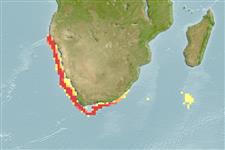Actinopterygii (ray-finned fishes) >
Gadiformes (Cods) >
Merlucciidae (Merluccid hakes) > Merlucciinae
Etymology: Merluccius: Latin, mar, maris = the sea + Latin, lucius = pike (Ref. 45335).
Environment / Climate / Range
Ecology
Marine; bathydemersal; non-migratory; depth range 200 - 1000 m (Ref. 6605), usually 400 - ? m (Ref. 58452). Deep-water, preferred 19°C (Ref. 107945); 18°S - 38°S, 11°E - 46°E (Ref. 58452)
Southeast Atlantic: Cape Frio, Namibia south to the Agulhas Bank and east to East London in South Africa. Western Indian Ocean: Madagascar Ridge (33°S,44°E).
Length at first maturity / Size / Weight / Age
Maturity: Lm 47.8 range ? - ? cm
Max length : 115 cm TL male/unsexed; (Ref. 27121); common length : 60.0 cm SL male/unsexed; (Ref. 1371)
Short description
Morphology | Morphometrics
Dorsal
spines
(total): 1;
Dorsal
soft rays
(total): 42-50;
Anal
spines: 0;
Anal
soft rays: 38 - 41. Body more slender than other hakes. Head large, about 25 to 30% of SL. Gill rakers short and thick with blunt tips. Pectoral fin tips reaching to level of anal fin origin. Color is steel gray on back, grading to silvery white ventrally.
Found near the bottom. Feeds on fishes, mysids, euphausiids and squids. Young feed mainly on euphausiids, but the diet becomes polyphagous with growth. Cannibalism has been observed in larger individuals (Ref. 9583).
Life cycle and mating behavior
Maturity | Reproduction | Spawning | Eggs | Fecundity | Larvae
Cohen, D.M., T. Inada, T. Iwamoto and N. Scialabba, 1990. FAO species catalogue. Vol. 10. Gadiform fishes of the world (Order Gadiformes). An annotated and illustrated catalogue of cods, hakes, grenadiers and other gadiform fishes known to date. FAO Fish. Synop. 125(10). Rome: FAO. 442 p. (Ref. 1371)
IUCN Red List Status (Ref. 115185)
CITES (Ref. 94142)
Not Evaluated
Threat to humans
Harmless
Human uses
Fisheries: highly commercial
Tools
Special reports
Download XML
Internet sources
